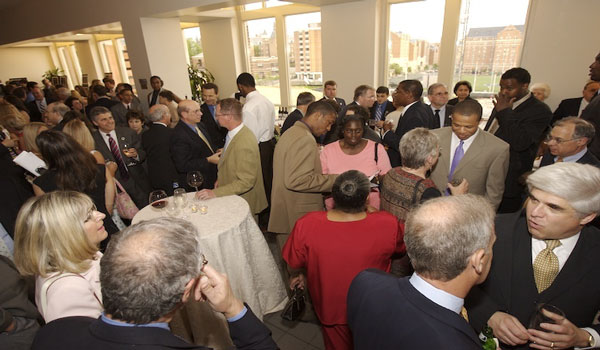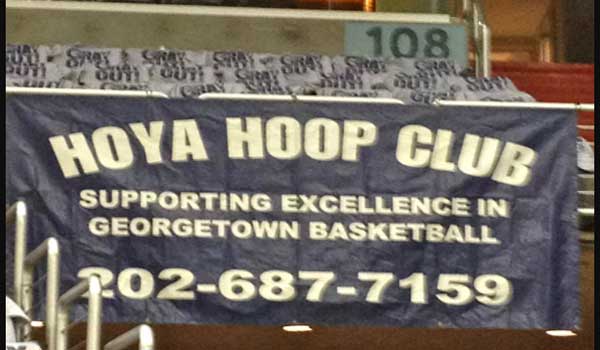| |
Part Five: The Two Way Street

Three months is not a long time to affect change throughout a program where the status quo has been a calling card for much of the last five decades. But when the summer concludes, the inevitable question follows: "what's next"? Or more to the point, "how can we help?"
A year ago at the John Carroll Weekend in Nashville, a panel discussion featuring athletic director Lee Reed and former Georgetown University Board of Directors chair Paul Tagliabue (C'62) took aim at the nascent entry of name, image, and likeness (NIL) into college athletics, with Tagliabue especially wary of the changes it would bring. One year and one Supreme Court case later, Tagliabue was not at John Carroll in San Francisco but Reed was, calling NIL a new era of athletics at Georgetown.
Ninety percent of Georgetown alumni have no idea what NIL is; to many of them, it's a word used in English football matches. Those that know probably don't know exactly what it is at Georgetown, and whether they are supposed to get behind it, or stay clear for the Wall Street Alliance to run it.
The question for this summer and beyond: what is the framework moving ahead for support of Georgetown Basketball?
For 45 years, that question was answered in three words: "Hoya Hoop Club".
Born out of an ad-hoc study from a group of volunteers known as the Committee on Basketball, the Hoop Club began in 1977, providing the first financial support model to the program at the dawn of the Big East era. Gifts to the Hoop Club totaled over $1 million annually through phonathons, events such as the annual team banquet, and what later became known as seat licenses for preferred locations at Capital Centre and
the current Capital One Arena.

At its core, the Hoop Club was a complementary fundraising operation to for men's basketball: it raised funds for items that the men's basketball budget could not afford, whether that was laptops for players studying on the road, a new scoreboard at McDonough, or even a Georgetown-branded floor at what was then known as MCI Center--something the Hoyas had never seen before while playing on the Washington Bullets' floor in Landover.
In 2004, then-athletic director Bernard Muir changed the rules of engagement, with the Hoop Club (and other team-specific support clubs) moving from complementary to supplementary fundraising: gifts to Georgetown basketball went straight to the team budget and were now at the discretion of the head coach, not a volunteer board. Inexorably, the visibility and vitality of the Hoop Club began to wane. Being a Hoop Club member was no longer a big deal. The last true awards banquet was in 2008, with a post-season reception for the players ending in 2018. The phonathon went the way of the landline, and bus trips to out of town games were deemed an unnecessary expense by University staff.
Even the annual Big East Tournament, which once featured the Hoop Club renting out the main ballroom at the Hotel Pennsylvania for fans after Georgetown games has gone the way of the now disappearing structure, with fewer and fewer events drawing a cross-section of fans.
That's no knock on the alumni volunteers that try to keep things moving, but the University no longer sees the Hoya Hoop Club as a central driver in fan (and financial) interaction. In the summer of 2023, that relationship is now even murkier.
If you missed the release or the subsequent comments on HoyaTalk or social media, the debut of Hoyas Rising as the school's NIL collective (even if they are not calling it that) came and went. As a for-profit Delaware company, it does not have access to University fundraising lists, and outside of its web site and a link on GUHoyas.com, it has no direct means of engaging with fans. But like its modern day counterpart in politics, the political action committee, organizations like this aren't really looking for your $25.00 gift. The PAC knows their people and those people know the PAC.
The Hoyas Rising site said that it is committed to serve student-athletes across all sports. Is it?
In Georgetown's introductory press release, Hoyas Rising leadership said it "everyone at Hoyas Rising is committed to helping all of the nearly 800 GU student-athletes realize the full potential of their brands," but it's not clear about the other side of the equation -- a collective, or what a collective is becoming: third party sponsorship and payments to players. If starting up a collective was a prerequisite to sign Ed Cooley, well, this is the business we have chosen.
But how far can a collective go outside basketball at Georgetown, and at what impact? Do payments apply to incoming soccer players? Track runners? Rowers? If Hoyas Rising secured $300,000 for an Auburn running back to transfer to Georgetown, does that run afoul of administrative expectations (known as the "ethos and culture" statement) built around a less competitive football program? Does raising funds across donors of many sports dilute the sums available to Cooley for basketball, or are other sports really not going to be pursued?
Maybe all this has been settled. Maybe, because it's Georgetown, it has not. But what is the message to the season ticket holder, the annual Hoop Club donor, or just the supporter with capacity (a fundraising term for lots of money) that really just wants to help Georgetown where it serves the most good--do they continue to give to the University or this new group, and in the end does it even matter? Absent that choice, is Hoyas Rising simply a PAC for 15 to 20 major donors to support coach Cooley and not really for anyone else?
James Langley, a former fundraising executive at Georgetown in the early 2000s, writes extensively about the alchemy of philanthropy. In a recent LinkedIn post, he writes:
"When fundraising falters it is often because the strategies of one construct are misapplied to another. The most common is to assume the practices of the church, from which so many of our fundraising strategies came, will work in the charity or the college (or any future-oriented enterprise). In higher education, for instance, we see efforts to pass an offering basket (annual giving) that fail because the organization has not built a strong sense of congregation among alumni nor provided inspiring guidance after graduation. Further, many grads are far more interested in pursuing what might be than in returning to what was. The "college," in those instances, fails as both a church and a future oriented institution."
A decade later, the name of Jim Langley is still a source of indigestion in some quarters on the Hilltop, inasmuch as he was seen as too invested in fundraising theory and not enough urgency to raise lots of money. Revisit the takeaway above: annual giving will fail "because the organization has not built a strong sense of congregation among alumni". If there is no direction on giving, no community of giving, and no results of what that giving provided, people will choose to give elsewhere--and they do. Two out of three Georgetown alumni vote with their wallets every single year and do not support the University. Men's basketball support has fallen even further, particularly among its own.
To realign Georgetown basketball in a new age of competitive opportunity and competitive pressure, its community needs to know what are the rules of engagement about support, and where that support should be directed to. Otherwise, the Ed Cooley era may be no more lasting than the Patrick Ewing era, because he will not have the financial tools with which to win and the fan base, already attrited by years of poor results and poor planning, will have moved on for good.
Support is a two way street, even if the University sometimes prefers a single lane. A reset of support won't be finished this summer, but it needs to start. As this series has tried to elaborate, there's a lot of work ahead, but the interest of the University and its fans are there for Ed Cooley to lead from the front.
Let's get to work.
|




